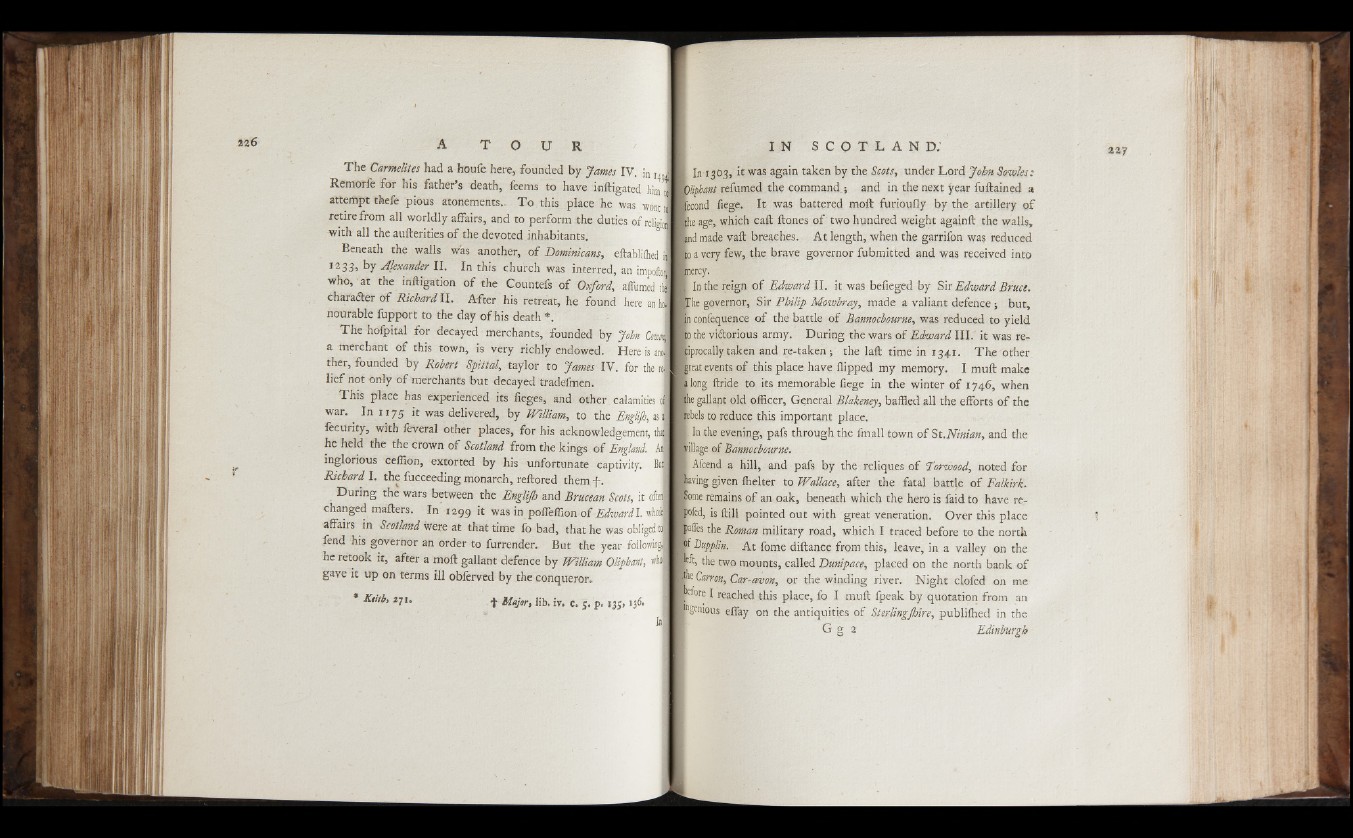
The Carmelites had a houfe here, founded by James IV. in u j
Remorfe for his father’s death, feems to have iniligated him J
attempt thefe pious atonements.. To this place he was wont 1
retire from all worldly affairs, and to perform the duties of reiirij
with all the aufterities of the devoted inhabitants.
Beneath the walls whs another, of Dominicans, eitablilhed 9
I233, by Alexander II. In this church was interred, an impoftol
who, at the inftigation of the Countefs of Oxford, affumed til
character of Richard 11. After his retreat, he found here an id
nourable fupport to the day of his death *.
The hofpital for decayed merchants, founded by John Cm\
a merchant of this town, is very richly endowed. Here is anJ
ther, founded by Robert Spittal, taylor to James IV. for the rel
lief not only of merchants but decayed tradefmen.
This place has experienced its fieges, and other calamities oj
war. In 1 175 it was delivered, by William, to the Englijh, as 1
iecurity, with feveral other places, for his acknowledgement, thaj
he held the the crown of Scotland from the kings of England. A|
inglorious ceffion, extorted by his unfortunate captivity. Bill
Richard I. the fucceeding monarch, reftored them f .
During the wars between the Englijh and Brucean Scots, it often
changed mailers. In 1299 it was in pofleffion of Edtvardl, wholl
affairs in Scotland were at that time fo bad, that he was obliged tel
fend his governor an order to furrender. But the year following!
he retook it, after a moil gallant defence by William Oliphcmt, ¿1
gave it up on terms ill obferved by the conqueror.
* Ktitb, 2 7 1 . | Major, lib. ir. c. 5 . p. 135, 136. 3
I In 1303, it was again taken by the Scots, under Lord John Sowles:
|0/iphant refumed the command -, and in the next year fuilained a
pcond fiege. It was battered moil furiouily by the artillery of
fee age, which caft Hones of two hundred weight againil the walls,
and made vail breaches. At length, when the garrifon was reduced
Ko a very few, the brave governor fubmitted and was received into
Inercy.
I In the reign of Edward II. it was befieged by Sir Edward Bruce.
¡¡The governor, Sir Philip Mowbray, made a valiant defence ; but,
|n confequence of the battle of Bannocbourne, was reduced to yield
|to the victorious army. During the wars of Edward III. it was reciprocally
taken and re-taken; the lail time in 1341. The other
■great events of this place have flipped my memory. I muil make
along ilride to its memorable fiege in the winter of 1746, when
■he gallant old officer, General Blakeney, baffled all the efforts of the
? rebels to reduce this important place.
I In the evening, pafs through the fmall town of St.Ninian, and the
pillage of Bannocbourne.
■ Afcend a hill, and pafs by the reliques of Torwood, noted for
paving given Ihelter to Wallace, after the fatal battle of Falkirk.
■ome remains of an oak, beneath which the hero is faid to have reiiofed,
is Hill pointed out with great veneration. Over this place I
lafles the Roman military road, which I traced before to the north
P Dupplin. At fome diftance from this, leave, in a valley on the
»hi the two mounts, called Dunipace, placed on the north bank of
I f Carrón, Car-avon, or the winding river. Night clofed on me
r t'ore I reached this place, fo I muil fpeak by quotation from an
igenious effay on the antiquities of Sterling/hire, publiihed in the
J G g 2 Edinburgh